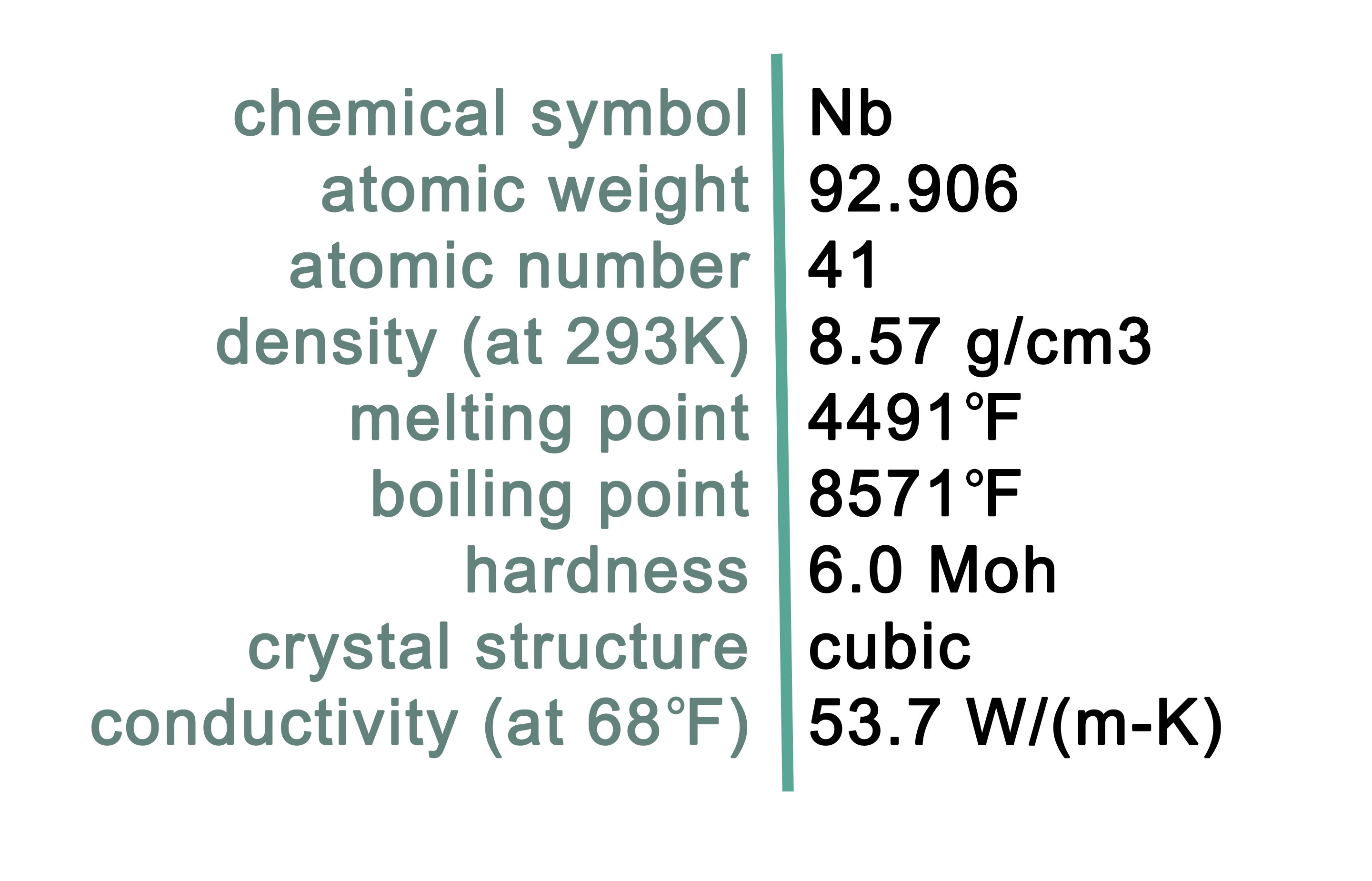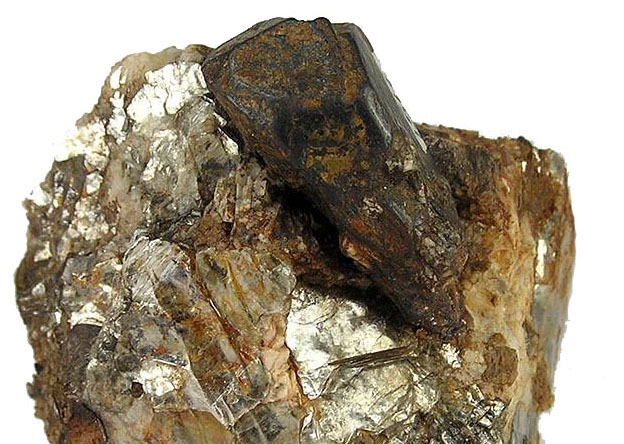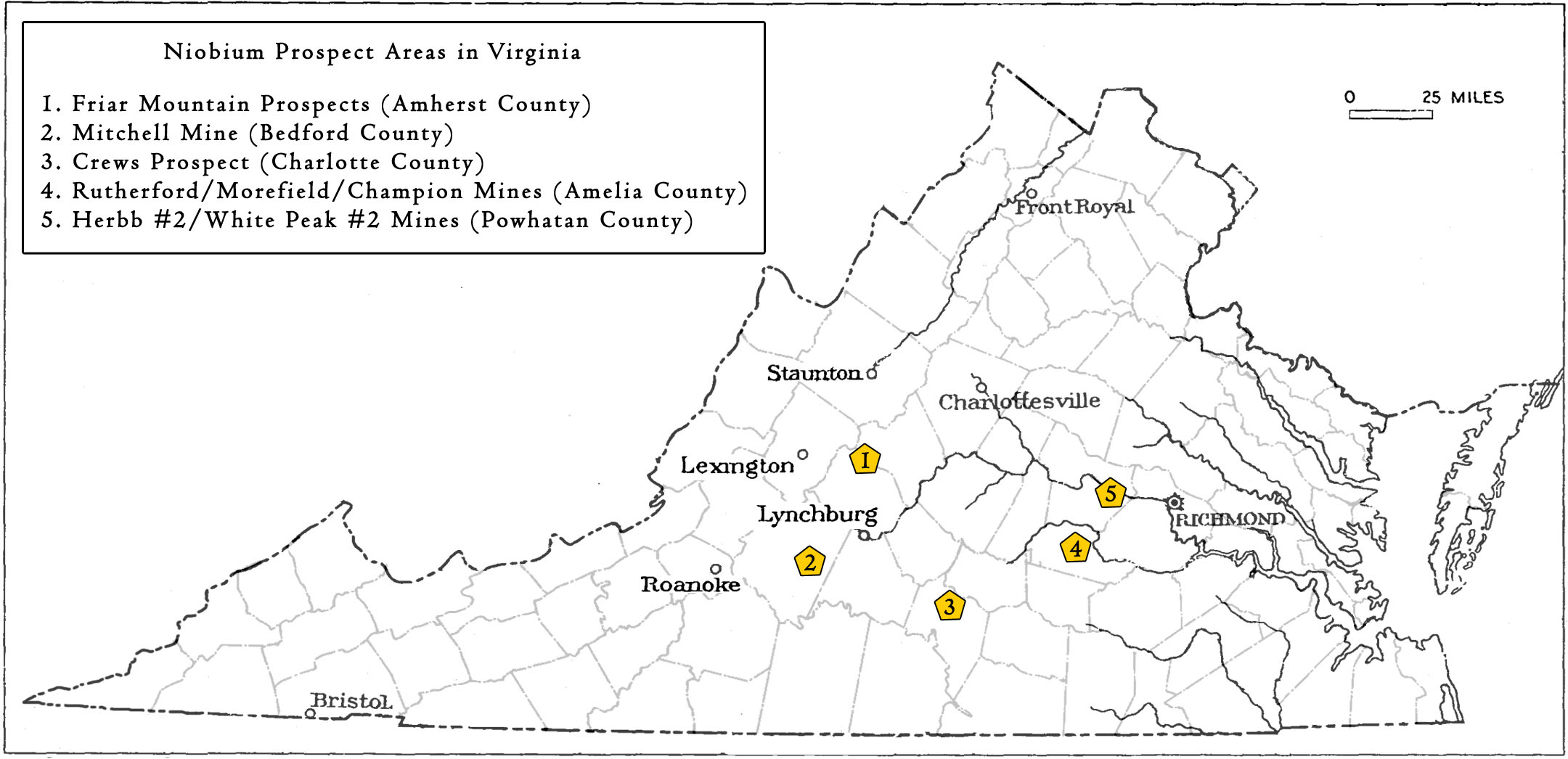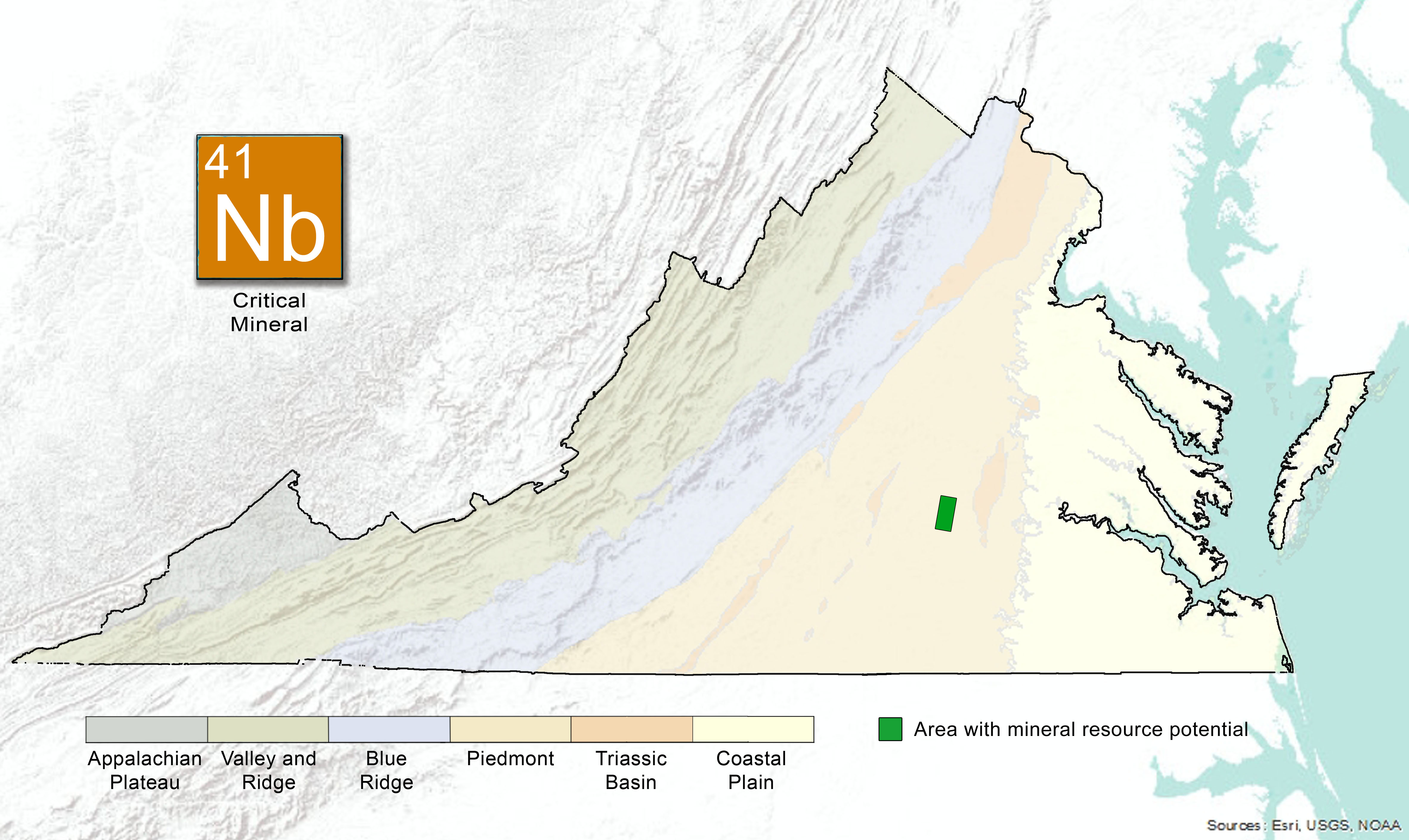Characteristics of Niobium
The element niobium is a silvery metal with a low density and the chemical symbol Nb. Niobium is a lustrous, ductile metal. It is a superconductor with a high melting point. Niobium is also highly resistant to heat and corrosion, and is generally non-reactive. Niobium is a strong metal that is almost always found together with the element tantalum (Ta). Niobium does not occur naturally as a pure metal, but is rather bound with other elements in minerals such as columbite (Table 1).


| Mineral Name | Chemical Formula | Specific Gravity | Nb % |
|---|---|---|---|
| Euxenite | (Y,Ca,Ce,U,Th)(Nb,Ti,Ta)2O6 | 4.85 gm/cc | 21-34 |
| Fergusonite | YNbO4 | 5.05 gm/cc | 37.8 |
| Lueshite | NaNbO3 | 4.61 gm/cc | 81.1 |
| Latrappite | (Ca,Na)(Nb,Ti,Fe)O3 | 4.39 gm/cc | 43.9 |
| Columbite | (Fe,Mn)(Nb,Ta)2O6 | 5.0 gm/cc | ≥ 33 |
| Ilmenorutile | Fex(Nb,Ta)2x4Ti1- x O2 | 4.61 gm/cc | 81.1 |
| Pyrochlore | (Na,Ca,Ce)2(Nb,Ti,Ta)2(O,OH,F)7 | 5.27 gm/cc | 34.3-86.8 |
Table 1: Minerals containing the element Niobium

The Apollo 15 Service Module made with
a niobium-titanium alloy.
Uses of Niobium
The element niobium was discovered in 1801, although often confused with tantalum. Niobium is considered a "critical mineral" in domestic metallurgical applications that serve aerospace, defense, and energy technologies (Fortier and others, 2018). Niobium is critical for technology. It is primarily used in metallurgy as an alloy with steel to improve strength and resistance to corrosion. Such steel is used for transportation infrastructure and gas pipelines. Niobium is also used by the aerospace industry as an alloy to produce engines and other components of jets and rockets. The medical industry requires niobium in order to produce the superconducting magnets within MRI scanners Niobium is also useful for electronics, optics, and the nuclear industry.

A columbite crystal (dark) with mica
Photo credit: Robert Lavinsky
Niobium Geology
Niobium often forms with the element tantalum in igneous rocks such as granite or pegmatite. Tantalum originates from tectonic plate convergence (during the formation of mountains), or plate divergence (during the formation of ocean basins). During these geologic events, plutons, dikes, and sills of magma intrude into the surrounding rock and cool to form coarse grained granites and pegmatites. The chemistry of the magma and surrounding rock largely determine which minerals form. Niobium and tantalum rich minerals may form in carbonatites (igneous rocks ≥50 percent calcite or dolomite), or in alkaline granites and syenites (rich in sodium and potassium sourced from the deep mantle).
| Mineral System | Deposit Type | Geologic Provinces |
|---|---|---|
| Climax-type | Pegmatite (NYF) | Piedmont |
| Placer | Columbite, tantalite | Coastal Plain |
Table 2: Prospective niobium mineral systems, deposit types (Hofstra and Kreiner, 2020), and geologic provinces in Virginia
Niobium in Industry
The element niobium is globally distributed, but generally in low concentrations. The U.S. maintains a supply of niobium in the National Defense Stockpile, but is 100 percent import reliant on imports from other countries including Brazil, Canada, Russia, and Germany. Historically, niobium has only been produced as a by-product of mining pegmatites for tantalum. Deposits rich in pyrochlore, the primary ore of niobium, were not discovered until the 1950s. In the United States, mining for niobium has not occurred since 1959. Concerns related to mining for niobium include disruption of the surrounding ecosystem, and potential radioactivity of the tailings which may contain thorium and uranium.
In Virginia, niobium is primarily found within the minerals columbite and pyrochlore. Such minerals are common in pegmatite dikes that have often been mined for other resources. Although niobium has not been directly mined in Virginia, several prospects have been identified within the past century.

Locations in Virginia sampled or prospected for Niobium
There are multiple historic prospects in Amherst County, notably Friar Mountain (also known as the John Campbell tract). Pegmatites from this area have been worked since 1874, with production primarily of allanite and mica (Pegau, 1932; Mitchell, 1977). Alhambra deposits from this Friar Mountain contain fergusonite (YNbO4) with 48.66 percent Nb2O5 based on chemical analysis (Mallet, 1877).
Bedford CountyA lenticular pegmatite dike at the Mitchell Mine (also known as Hottinger Mine) in Bedford county has been worked for perthitic-plagioclase feldspar, allanite, and massive quartz from 1928 through the mid-1930s, and then intermittently until 1965 (Pegau, 1932). During operation, an open pit approximately 50x450 feet and 150 feet deep was dug to expose a pegmatite dike within Alligator Back Formation meta-argillite and schist. Small crystals of columbite from this area were recovered in the 1990s and chemically analyzed to contain approximately 46-71 percent niobium (Giannini and Sweet, 1991).
Charlotte CountyThe Crews Prospect (possibly also the Davis Prospect in Pegau, 1932) is located just southeast of Madisonville in Charlotte County. Here, small pits were dug in the early 20th century to expose a 10-foot wide pegmatite dike (Aaron Formation). Primarily, feldspar and quartz were of interest at this location, although mica, and beryllium were also identified. Columbite samples analyzed in 1991 contain 76.9 percent niobium (Giannini and Sweet, 1991).
Amelia County
One of the historic Morefield mine shafts.
From Giannini and Sweet, 1991.
Near the Amelia Court House, the well-known Morefield Mine has provided hundreds of tons of feldspar, mica, beryl, and tantalite-columbite since 1929. Open cuts, pits, trenches, shafts, and drill holes expose and explore the underlying pegmatite, which is a dike at least 1,100 feet in length by 30 feet thick. Niobium occurs within the minerals columbite and tantalite in a zone of perthite rock. Columbite mineral samples from the Morefield mine have been collected and analyzed several times in the 1980s, and contain approximately 55 percent niobium (Giannini and Sweet, 1991). Some of the tantalite crystals are reported to be well formed and weigh as much as half a pound (Lemke and others, 1952). Approximately 1,423 pounds of tantalum/niobium-containing minerals were extracted from this site between 1929 and 1944 (Lemke and others, 1952).
A couple miles to the east, the Rutherford pegmatite mines are also of interest. Here, the underlying Amelia pegmatite has been mined since at least 1873 for mica and amazonite (Giannini and Sweet, 1991; Lemke and others, 1952). Several open pits and shafts were constructed and mostly mica was removed until the sites were abandoned in 1943. Although the underground workings are flooded, the Rutherford Mines were more recently open to the public for mineral collecting until the 1980s. This location was never mined for niobium, however, chemical analyses of columbite mineral samples from the pegmatite suggest a composition of up to 48.41 percent niobium.
Also in Amelia County, the Champion mine was heavily worked for mica beginning in 1873. Several open cuts and shafts were dug to access a pegmatite body surrounded by schist and gneiss. Between 1913 and 1914, 200 thousand pounds of mica was extracted, some of which was cut into twelve-inch sheets. Although the site was buried in 1984 and most of the mica has been mined out, samples of the local Amelia tantalite have a 24.47 percent niobium composition (Giannini and Sweet, 1991).
Powhatan CountyIn Powhatan County, two mines produced mica from the underlying Amelia pegmatite. The Herbb Number 2 mine near Flat Rock was open for a short period beginning in 1944. Samples of tantalite and wodginite obtained in 1991 were reported to contain 21.2 percent niobium. Columbite mineral samples from the White Peak Number 2 Prospect (approximately 2 miles southwest of the Herbb No. 2 mine) contain 61.85 percent niobium. Several pits and trenches were dug here in 1944. Although a small amount of mica was mined, no other commodities were extracted.
Selected References:
Brown, W.R., 1962, Mica and Feldspar Deposits of Virginia: Virginia Division of Mineral Resources, Mineral Resources Report 3, 195 P.
Dietrich, R.V., 1970, Minerals of Virginia: Virginia Polytechnic Institute, Research Division Bulletin
Fortier, S.M., Nassar, N.T., Lederer, G.W., Brainard, J., Gambogi, J., and McCullough, E.A., 2018, Draft Critical Mineral List - Summary of Methodology and Background Information - U.S. Geological Survey Technical Input Document in Response to Secretarial Order No. 3359: U.S. Geological Survey Open-File Report 2018-1021, 15 p.
Giannini, W.F., and Sweet, P.C., 1991. Tantalum and Niobium Resources in Virginia, Virginia Division of Mineral Resources, Publication 115.
Hofstra, A.H., and Kreiner, D.C., 2020, Systems-Deposits-Commodities-Critical Minerals Table for the Earth Mapping Resources Initiative: U.S. Geological Survey Open-File Report 2020-1042.
Lemke, R.W., Jahns, R.H., and Griffitts, W. R., 1952, Mica deposits of the southeastern Piedmont, pt. 2. Amelia District, Virginia: United States Geological Survey Professional Paper 248-B, p. 103-139.
Mallet, J. W., 1877, On sipylite, a new niobate from Amherst County, Virginia: American Journal of Science (3d), v. 14, p. 397-400.
Mitchell, R.S., 1977. Some noteworthy minerals from Virginia: Rocks and Minerals, v. 52, no. 5, p. 221-229.
Niobium and Tantalum, Chapter M in Critical Mineral Resources of the United States - Economic and Environmental Geology and Prospects for Future Supply. U.S. Geological Survey Professional Paper 1802-D
Pegau, A.A., 1932, Pegmatite Deposits of Virginia, Virginia Geological Survey Bulletin 33.
Penick, D.A., 1985, Virginia, Mineral Locality Index: Rocks & Minerals, Vol 60, No 4, p. 164-170.

.jpg)
